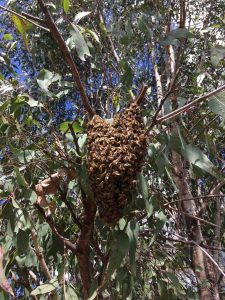Swarms are a natural process of a bee colony. Swarms occur because the space in which the colony lives has become too small for it. The colony decides its time to split and along with the existing queen, half the colony takes off to find a new home. They leave behind a yet-to-emerge queen, and a smaller colony to care for the baby bees – considerate really!
The important thing to remember if you come across a swarm of bees is that they are usually not aggressive whilst swarming. This is because they have no territory to defend. Within the swarm will be their queen, and their primary goal will be to find a safe haven for her and the colony.
Swarms occur in spring time but can occur at any time in reality. For SEQ, this means July through October is Swarm Season! Swarms are not dangerous but can be a public nuisance. Please don’t fumigate or poison them as there will be a beekeeper willing to come and rectify the issue for you. (see list below).
Swarms are identifiable as a large group of bees normally clustered around some odd object or a tree. Typically, they congregate on something close to the location from where they have just come from whilst they await the scout bees returning with the location of their new home. A swarm can look like many things but typically it is characterised by audible buzzing and the air filled with bees, flying in a swirling like of pattern through the air. Once they land, they are clustered around the object, with many bees festooning downwards.
If you come across a swarm, stay calm. Stay curious. And call a local beekeeper!
|
These contacts in most cases will collect a swarm for no charge but please check before requesting their services. Equally, being on this list does not guarantee their availability when required. Please be respectful of their time.
Please Note:
Beekeepers participating in the private collection of swarms for the general public do so in a private capacity, at their own risk and not as representatives of the Association.
If you would like to be added to this list please contact us and provide your information
Before you call the beekeeper – things to have ready:
– a picture of the swarm to send to the beekeeper.
– how big is the swarm? Is it the size of an orange or a watermelon?– exact address/location of the swarm.
– is it up high or down low, advise if you perceive any hazards.
– do not approach the hive unless with an experienced beekeeper.
– notified people in the vicinity and secure pets.
– do not spray the hive with pesticide/water/smoke to calm the hive down.
